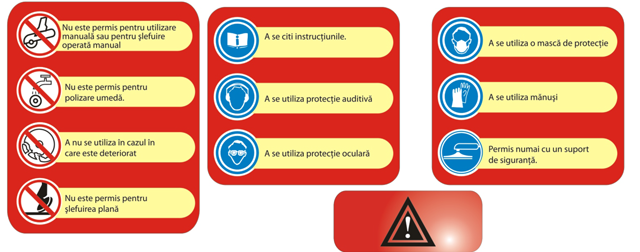Cut-Off and debburing wheels
General recommendations
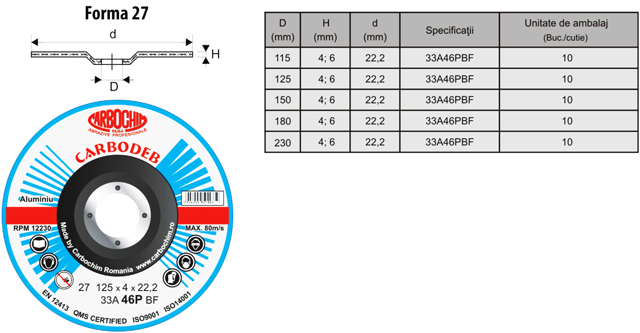
Marking
Abrasive discs are high productivity cut-off wheels and deburring tools that are able to work at high peripheral speeds and that are used on hand power tools or stationary machines. Carbochim's discs trade marks Crabodeb® are recognized by high efficiency, short time and minimum effort during cutting/deburring process.
Safety is the main objective and in this reason Carbochim cut-off and deburring wheels are in compliance with international requirements regarding safety work: EN 12413 and FEPA.
Carbochim's abrasive discs are suitable for a wide range of applications and are recommended based on operation type (cutting or deburring process), machine type, work material ( steel, stainless steel, aluminium, stone, cast iron ) and also based on required parameters in cutting and deburring process .
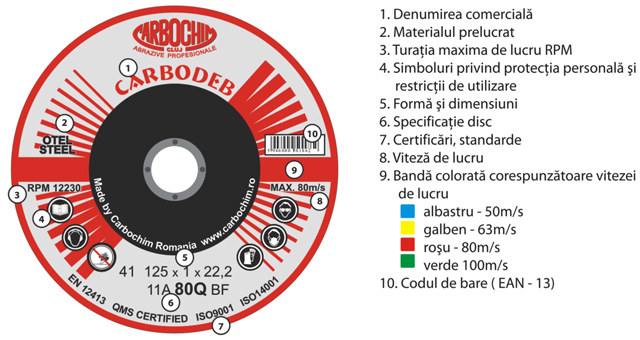
For an adequate selection of discs specification based on processed material, Carbodeb® discs are marked in different colors, as follows:

1. Cut-off and deburring wheels for steel
Quality is an important parameter of processes and of products, and in this reason Carbochim S.A. apply modern methodes of production and a rigurously control of raw materials. By selection and combination of high quality raw materials, the Carbochim's cut-off and deburring wheels offer high endurance and rapid power feed. The consistent look for efficiency, the careful control of final product as well as an exemplary technical assistance recommend these products to be the optimum solution for the most exacting cut-off and deburring processes.
1.1. Professional cut-off wheels For hand power tools
-shape 41 - flat cut-off wheels reinforced with glass fiber inserts
-manufactured by special abrasives combination, they have the advantages of rapid and clean cuttings, without burrs, less noise and dust
-recommended for steel profiles, pipes, bars, metallic plates, building materials etc.
-Maximum rotation speed permissible 80 m/s
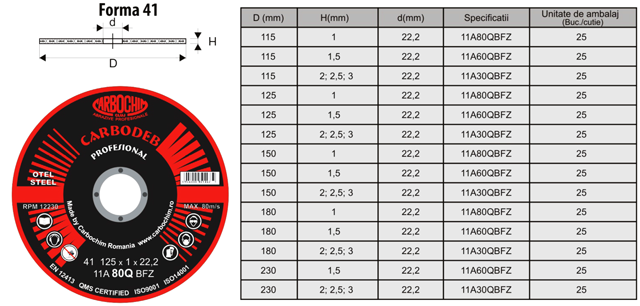
For stationary machines:
-shape 41 - flat cut-off wheels reinforced with glass fiber inserts
-professional cut-off wheels that grant the quality exactingness required by cutting process
-the high efficiency and aggresiveness recommend these cut-off wheels to be the optimum solution for professional use
-recommended for cutting of castings, billets, forged pieces, rails, bars and pipes of large sections
-maximum rotation speed permissible 80 m/s -100 m/sec.
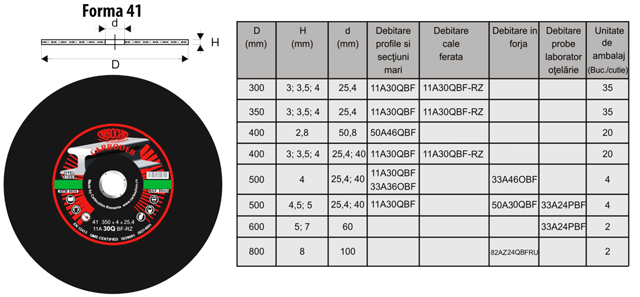
For hand power tools:
-shape 27 - depressed center deburring wheels reinforced with glass fiber inserts
These wheels are efficiently used in applications where a big quantity of added processing material is required to be removed , like: cleaning and deburring of forged and cast-on pieces, casting defects elimination , welding adjustements
-Maximum rotation speed permissible 80 m/s
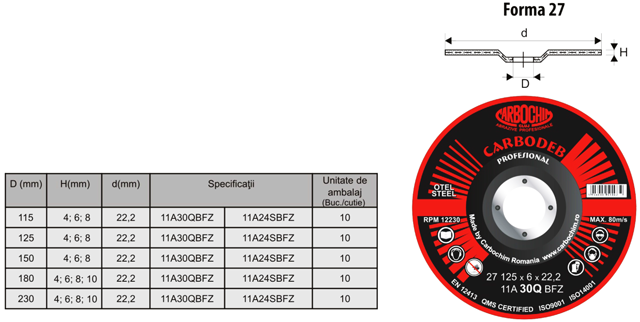
1.2 General cut-off and deburring wheels
-for general use with advantage of optimum quality/ price ratio
-recommended for cutting and deburring angle bars, pipes, bars, metallic plate, building materials etc. with hand power tools. Optimum quality / price ratio.
-Maximum rotation speed permissible 80 m/sec.
For hand power tools:
-shape 41 - flat cut-off wheels reinforced with glass fiber inserts
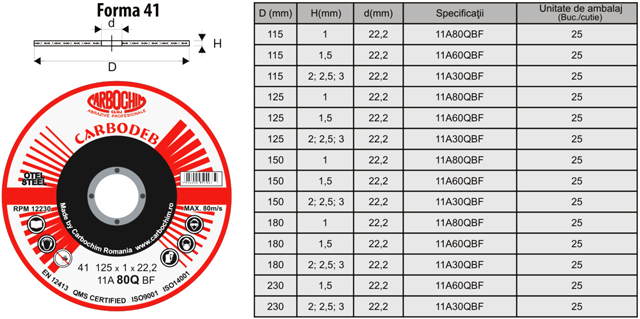
-shape 42 - depressed centre cut-off wheels reinforced with glass fiber inserts
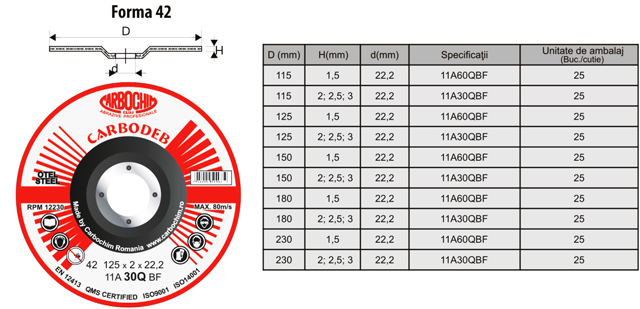
- shape 27 - depressed centre deburring wheels reinforced with glass fiber inserts
These discs are efficiently used in applications where a big quantity of added processing material is required to be removed; like: cleaning and deburring of forged and cast-on pieces, casting defects elimination , welding adjustements. Optimum quality/price ratio.
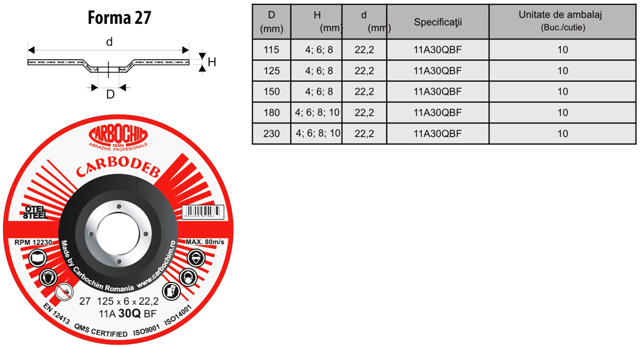
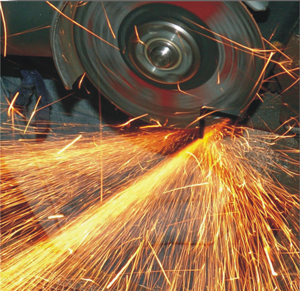
2. Cut-off and deburring wheels for stainless steel (inox)
Cut-off and deburring wheels that grant the following advantages for cutting and grinding process: clean and rapid operating with low effort, very accurate , noiseless, without dust and without color return or burrs.
-Maximum rotation speed permissible 80 m/sec.
For hand power tools:
-shape 41- flat cut-off wheels reinforced with glass fiber inserts
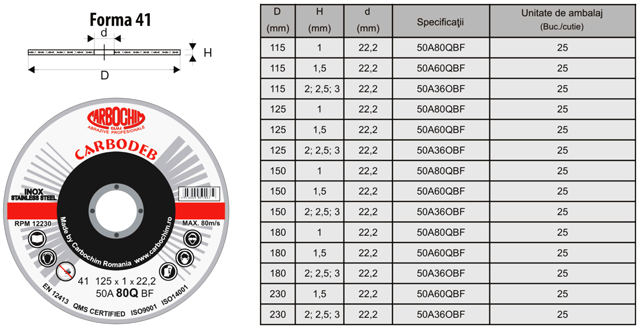
-shape 27 - depressed center deburring wheels reinforced with glass fiber inserts
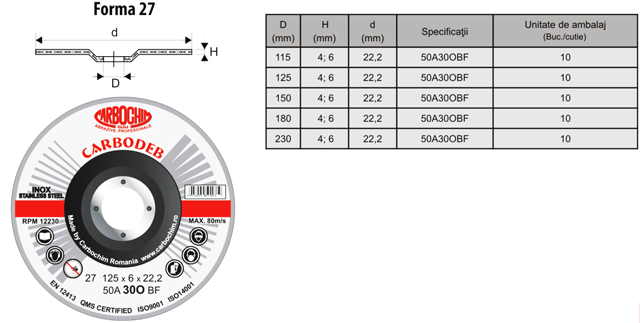
3. Cut-off and deburring wheels for aluminium
Cut-off and deburring wheels that grant the following advantages for cutting and grinding process: clean and rapid operating with low effort, very accurate , noiseless, without dust and without color return or burrs.
- Maximum rotation speed permissible 80 m/sec.
For hand power tools:
-shape 41 - flat cut-off wheels reinforced with glass fiber inserts
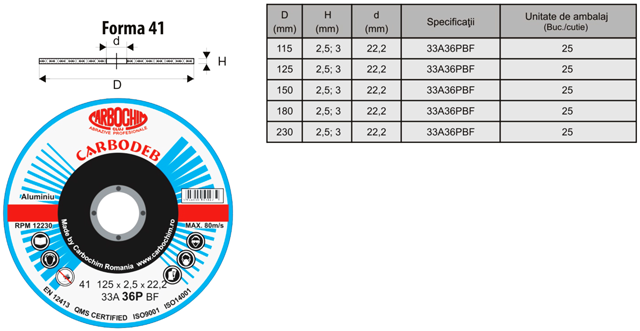
-shape 27 - depressed centre deburring wheels reinforced with glass fiber inserts

4. Cut-off and deburring wheels for cast iron
Cut-off and deburring wheels reinforced with glass fiber inserts, special made to grant a high efficiency in cast-iron processing.
-Maximum rotation speed permissible 80 m/sec.
For hand power tools:
-shape 41 - flat cut-off wheels reinforced with glass fiber inserts
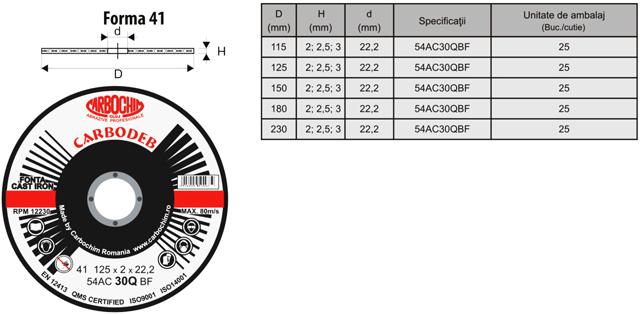
-shape 27 - depressed centre deburring wheels reinforced with glass fiber inserts
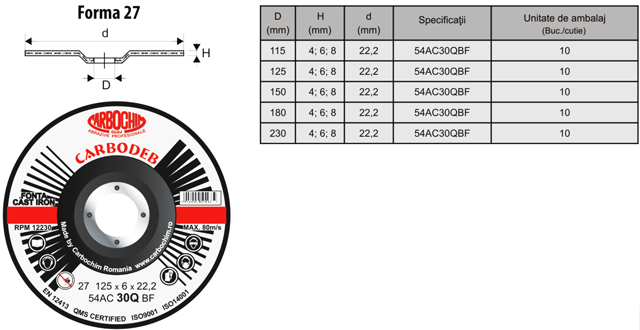
5. Cut-off and deburring wheels for stone
Cut-off and deburring wheels suitable for cutting and deburring natural stones or ceramics that are used in constructions: plates, bricks, tiles, concrete etc.
-Maximum rotation speed permissible 80 m/sec.
For hand power tools:
-shape 41 - flat cut-off wheels reinforced with glass fiber inserts
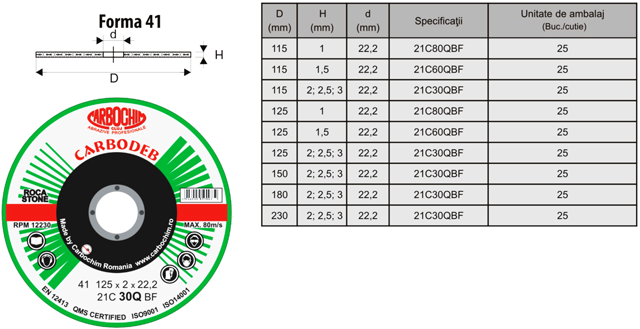
-shape 27 - depressed centre deburring wheels reinforced with glass fiber inserts
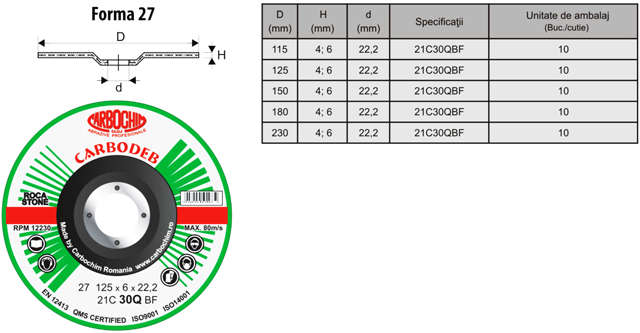
6. Cut-off and deburring wheels for heat-sensitive materials
For stationary machines:
- shape 41 - flat cut-off wheels without reinforcements
These cut-off wheels used for heat sensitive materials cutting are thin and exra-thin cut-off wheels of fine grit sizes which are manufactured in a wide range of specifications that grant high cutting parameters without structural modifications due to overheating or local deformations.
These cut-off wheels are recommended for cutting of pieces of different profiles! metalographic samples) and for special tools sharpening (saw strips, control cable conduit, canulaes, elastic bushing etc.) on stationary machines with maximum speed of 32-80 m/sec.
6.1. Cut-off wheels for metalography
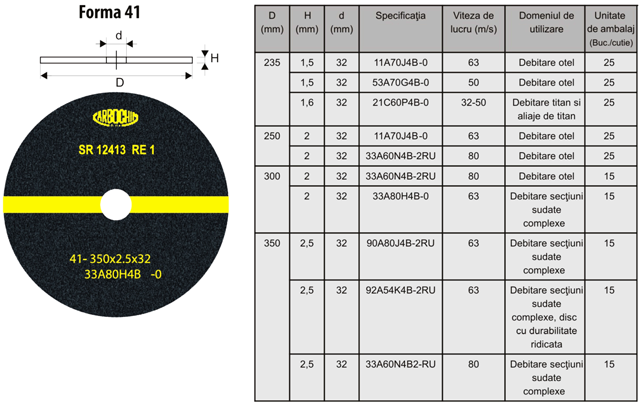
6.2. Cut-off wheels for control cable conduit, canulaes cutting and for elastic bushing sloting.
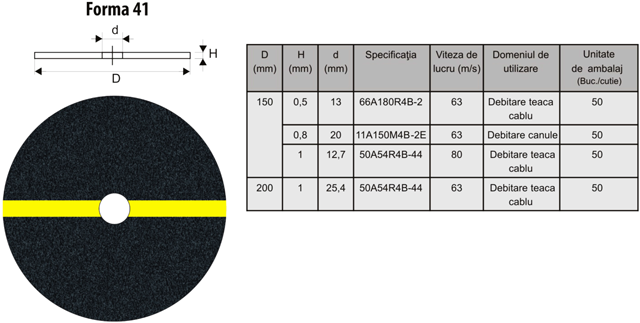
6.3. Cut-off wheels for saw strips cutting and sharpening
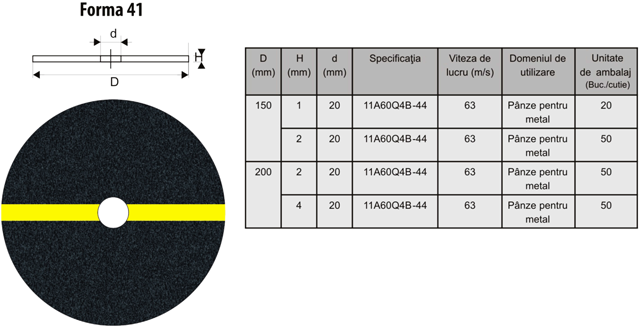
Safety rules
General saftey rules
Abrasive products improperly used can be very dangerous.
-Always follow the instructions provided by the abrasive product and machine supplier.
-Ensure that the abrasive product is suitable for its intended use. Examine all abrasive products for damage or defects before mounting.
-Follow the correct procedures for handling and storage of abrasive products.
- Be aware of the hazards likely during the use of abrasive products and observe the recommended precautions to be taken:
- Bodily contact with the abrasive product at operating speed.
- Injury resulting from product breakage during use.
- Grinding debris, sparks, fumes and dust generated by the grinding process.
- Noise.
- Vibration.
Use only abrasive products conforming to the highest standards of safety. These products will bear the relevant EN standard number EN12413.
Never use a machine that is not in good working order or one with defective parts.
Employers should carry out a risk assessment on all individual abrasive processes to determine the appropriate protective measures necessary. They should ensure that their employees are suitably trained to carry out their duties.
PRECAUTIONS AGAINST LIKELY HAZARDS
Bodily contact with the abrasive product
- Always take great care and attention when using abrasive products. Tie back long hair and do not wear loose clothing, ties and jewellery.
- Prevent accidental start-up of the machine before mounting or changing an abrasive product.
- Isolate machines from their power source where necessary.
- Never remove guards from machines where fitted and ensure they are in good condition and properly adjusted before starting the machine.
- Always use gloves and suitable clothing where the workpiece or machine is hand-held. For gloves, a minimum protection level of EN 388 Category 2 is recommended.
- After switching off the machine, ensure the product has come to rest before leaving the machine unattended.
Injury caused by product breakage
- Always handle abrasives with great care, they are easily damaged.
- Examine all products for defects or damage before use.
- Store abrasives in dry, frost-free conditions avoiding wide variations in temperature.
- Ensure they are properly protected and supported to prevent damage and distortion.
- Coated abrasives should be stored at 18-22° C, 45-65% relative humidity.
- Abrasive belts should be hung on a rod or peg not less than 50mm diameter.
- Check abrasive product or package for any warnings or other safety information.
Noise
- Ear protection complying with EN352 is recommended for all applications where the workpiece or machine is hand-held, irrespective of the noise level.
- Ensure that the correct abrasive product is selected. An unsuitable product can produce excessive noise.
Vibration
- Processes where the workpiece or machine is hand-held can cause vibration injury.
- Action needs to be taken if tingling, pins and needles or numbness is experienced after 10 minutes continuous use of the abrasive product.
- The effects of vibration are more pronounced in cold conditions so keep the hands warm and exercise hands and fingers regularly. Use modern equipment with low vibration levels.
- Maintain all equipment in good condition and stop the machine and have it checked if excessive vibration occurs.
- Use good quality abrasive products and keep them in good condition during their life.
- Maintain mounting flanges and back-up pads in good condition and replace if worn or distorted.
- Do not grip the workpiece or machine too tightly and do not exert excessive pressure on the abrasive product.
- Avoid continuous use of the abrasive product.
- Use the correct product. An unsuitable product can produce excessive vibration.
- Don't ignore the physical symptoms of vibration - seek medical advice.
Injury caused by product breakage
- Ensure that the correct abrasive product is selected. Never use a product if it cannot be properly identified.
- Follow the instructions provided by the abrasive product or machine supplier when mounting abrasive products.
- Observe any mounting indications marked on the product such as direction of run or mounting position.
- Never force the abrasive product onto the mounting fixture or modify it to fit.
- Never exceed the maximum operating speed where specified.
- Check that the correct mounting devices are used and that they are undistorted, clean and free from burrs.
- Use mounting blotters where supplied.
- Do not tighten the mounting device excessively.
- After mounting or re-mounting an abrasive product, conduct a trial run at operating speed with the guard in place for at least 30 seconds, standing clear of the machine before use.
- Never remove guards from machines where fitted and ensure they are in good condition and properly adjusted.
- Ensure that the workpiece is secure and properly supported. Ensure that work rests are properly adjusted and secure.
- Never start the machine with the workpiece in contact with the abrasive product.
- Never apply excessive force or shock to the abrasive product or let it overheat.
- Do not grind on the part of the product that is not designed for the operation. Avoid grinding with the edge of abrasive belts, use the centre of the belt if possible.
- Avoid clogging and uneven wear to ensure that the abrasive product is working efficiently.
- Let the abrasive product stop naturally, not by applying pressure to its surface.
- Turn off and spin out excess coolant before stopping the machine.
- Do not leave abrasive belts under tension when not in use.
Grinding debris sparks, dust and fumes
- Exposure to dust generated from workpiece and/or abrasive materials can result in lung damage and/or other physical injury.
- All dry grinding processes should be provided with adequate extraction facilities.
- Do not use abrasive products near flammable materials.
- The use of respirators complying with EN 149 is recommended for dry grinding processes even if extraction systems are provided.
- Guards where provided should be adjusted to deflect sparks and debris away from the operator.
- Take additional measures to protect people working nearby.
- Eye protection minimum EN166 B level protection level is recommended for all machine using abrasive products.
- Be sure that you have chosen the appropriate abrasive product. An unappropriated product can produce dust in excess.
Disposal of abrasives
Used or defective abrasives should be disposed in accordance with local or national regulations. Further information can be obtained from material safety data sheets provided by the supplier. Be aware that the abrasive product may be contaminated with material from the workpiece or process after use. Disposed abrasive products should be damaged to prevent them from being taken from waste skips and reused
